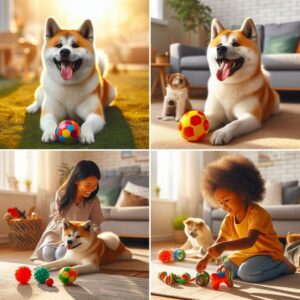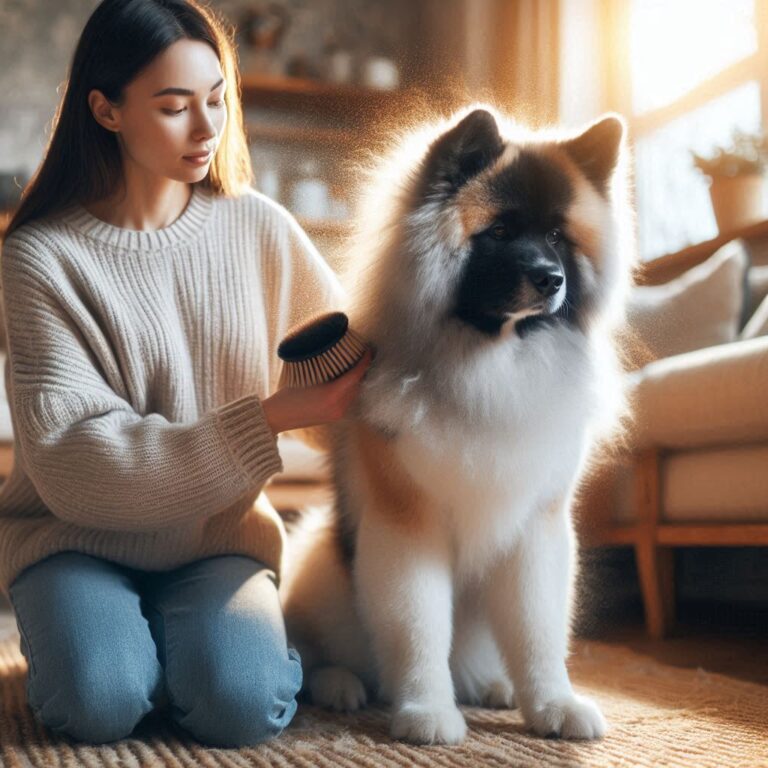How to Keep an Akita Entertained Both Indoors and Outdoors

Are you dog-sitting an Akita or as a new owner, you are wondering how to keep yours entertained? Well, I was like you some years ago when I got Avena (my first Akita). I wasn’t sure what to do to make her happy and get her active.
I had always known that Akitas were quiet dogs but could be playful if they wanted to, but I struggled with finding the best ways to get her amused.
Over time, I discovered a lot of strategies to keep an Akita entertained and they’ve helped me make the most of my time with Akitas.
In this article, I’ll be sharing some of the things I have learned about keeping an Akita entertained so you do not have to struggle like I did.
How to Keep an Akita Entertained
Akitas are independent dogs so getting them to play and run around like other dogs can be a hard nut to crack. Here are some of my best methods (and others that I borrowed) that can help you keep an Akita entertained:
- Take them hunting
- Play fetch
- Teach them hold/drop
- Conduct object identification exercises
- Go for strolls
- Get them interactive toys
- Play hide and seek
Let’s discuss each strategy and how you can use them to make your Akita stay happy.
Taking Them Hunting
Akitas are known to be hunting dogs. From their origins in Japan, they were trained to hunt bears and other animals.
Nearly a century today, Akitas still retain their hunting instincts. If you have a farm or an area where you can go hunting, your Akita is going to be the best hunting buddy you can get. The moment it is in the field, you’ll typically find it chasing birds, rabbits, or anything that creeps around in the woods.
Before you can take a dog out to the field for hunting, you must have trained it properly. You must have helped it to master staying and sitting commands so you don’t have them running after everything.
Play Fetch
Fetch is one of the best ways to satisfy a dog mentally and physically. It doesn’t matter what breed the dog is, playing fetch is one of the most satisfying activities for dogs.
Getting your dog to play fetch the first time can be a difficult process. Contrary to popular opinion, dogs do not play fetch by default. You can get them to pick things up but if it is “fetch” as it is supposed to be, not every dog can.
To teach your Akita fetch, I’ve got a simple trick:
- Pick up something like a ball or disc and give it to your dog. Ask your to “hold.” if it does, praise it immediately.
- Next, toss the item just a few distance from you. It shouldn’t be too far. Just a few feet from where the first action took place.
- As the dog picks it up, immediately begin to cheer it to bring the item back to you. You may need to bend a little so you don’t look too tall. The dog must maintain a straight line between going to pick the ball and bringing it back to you.
- Repeat the steps above until you can get the dog to fetch the ball and come straight to you without meandering. Give it a treat and cheer for it as a reward.
- Increase the distance and use words like “chase” or “go” to let your dog follow the ball as soon as you throw it.
- Continue repeating until the dog gets acquainted with the “hold,” “fetch,” and drop commands.
This exercise will require a lot of energy because you’ll need to show some enthusiasm to get your Akita willing and ready to play fetch. Once they get a hang of it, because of the cheers and treats, it’ll become effortless.
Teach Them Hold/Drop
Akitas are very intelligent dogs and you won’t have a hard time getting them to pick and drop.
I started with my Akita’s toys. I’ll hand her toy to her and when she collects it, I’ll use the command “hold” and cheer her up. After a few seconds, I’ll tell her to drop, then reward her. I’ll repeat this process for days, giving her rewards for every successful completion.
After a while, I’ll begin to stretch my hands to collect the item from her using the “give me” command. She won’t get it at first and I won’t reward her. Once she can give me the item, I’ll reward her.
The essence of rewarding your Akita is to connect the action with a reward.
Conduct Object Identification Exercises
I used this exercise to turn my Akita into my personal assistant. It is something like the “hold” and “drop,” but this time instead of focusing on things she can play with, I tried things she wouldn’t fancy picking up.
Interestingly, I was able to get my Akita to pick up stuff like my car key, pillow, and her toys and either give them to me or drop them in a specified location.
To get this done, I needed to make an object look interesting to my Akita. So, I got a blanket and placed it on the fall. It is important not to start with something of high value.
If you have introduced the “hold” and “drop” commands to your Akita, it’ll help you achieve this. Otherwise, you can try to get your dog interested in the item by waving it in their face. The goal is to make her comfortable with grabbing the item even when it is not their toy.
After playing with the item for awhile, I get my Akita to stop and drop it. Then pointing to it, I ask her to either “pick it” or “get it.” When she does, I make her let go and reward her. I’ll repeat keeping it down and using the commands to make her get the item.
You can also add a command like “let go” to make your dog let the item go before rewarding her.
This is different from fetch because in fetch you are getting your dog to pick up a moving object but in this case, your dog is picking up something static.
It is important to note that you will need to be a lot more enthusiastic and playful to get your Akita to obey you. They won’t do well when you sound like you are commanding or being rigid. During the training, you’ll need to playfully and enthusiastically get them to perform the actions.
Now, introduce distance and do it gradually. I will place the blanket just behind Avena at the time and pointing to it, tell her “Get it.” She may not want to go but by constantly asking her to, she’ll get it and do it. When she picks up the item, ask her to “let go” and reward her.
Keep doing this and increasing the distance. Remember you are not playing fetch. So you have to keep the object and make your dog walk to it, pick it up, and bring it to you.
Because you’ll want the dog to go as far as climbing up the stairs to bring your keys and maybe follow you to your car with it, you can make it pick up the item and bring it to you while you act like you are walking away.
At this point, your Akita will know that they’ve got to hold on to it until you are ready to get it from them.
Sometimes, because of the way you played with it from the beginning, they can pick up the item, and bring it to you, but play with it instead of giving it to you. This is why introducing the “let go” command is quintessential so that your Akita can let go without struggles. In letting go, I find out that dogs typically just drop the item. So I began to use “hand it” with my hand stretched to receive.
You’ll have to motivate your Akita to get them to do what you say and do not be unwilling to track back during your training to get them in sync.
When your Akita has mastered picking up and letting go of the item you were experimenting with, you can then introduce actual things like your shoes, pillows, phone, car keys, baseball bat, and so on. You can tell your dog to pick any of the items up using the name together with the command you have been practicing with for picking up items.
If they are unwilling, which I expect them to be, shorten the distance between you and the item and give them a higher reward treat.
Note: Your Akita will not respond instantaneously when you change the object or setting. So, you’ll have to work with it on different settings and for different items. You need a lot of energy to do so and there’s no need rushing.
Go For Strolls
Taking a walk with your Akita can be a demanding activity. Akitas like to explore and you may have a hard time keeping your Akita under control when you are outside.
There are two things I highly recommend that must be in place before attempting to take your Akita outside:
- Your Akita must be familiar with sit and stay commands
- Your Akita should know when you are calling it and respond appropriately
If your Akita has not learned or isn’t completely obedient to your “sit” and “stay” commands and does not respond to your calls, you should only go for walks in leashes or in your neighborhood.
Aside from helping your dog to stay fit and happy, taking leisurely strolls with your dog is also beneficial to you.
Get Them Interactive Toys
Understand that I said you should get your Akita interactive toys and not just toys. Interactive toys are the ones that ensure mental stimulation and activate your Akita’s problem-solving skills. Some of them include:
- Squeaky balls that make funny sounds when handled
- Treat-dispensing toys that are designed to release treats when your dog begins to engage them
- Tug toys that are pulled on either with trees or with you
- Rip-and-reveal plush toys that tear apart to reveal concealed items
- Kong jumblers
- Tooth-cleaning toys
- A flopping fish toy
- Rechargeable self-moving balls
- Teaser poles
- Treat puzzles
Play Hide and Seek
Hide and seek is one of my favorite things to do to keep my Akitas entertained. I could tell them to “stay” in the sitting room while I go outside and hide in the yard. Then, I’ll call out their names and when they find me, I run and let them chase me for treats.
This requires some energy but your dogs will be ready to go all the way. Do this often and they’ll be interested to play especially when they have to chase you to get rewards.
Important Points to Note When Attempting to Play With/Train Akitas
There are a lot of things I’ve seen several pet parents fail to understand when dealing with Akitas. They complain about their Akitas not being smart or playful even though they read and hear other Akita owners sharing stuff about theirs.
On this note, there are a couple of things to be wary of when you get an Akita or are trying to train or play with it.
Akitas are Independent and May Come Off as Disobedient
Generally, Akitas are very independent dogs. They only see the need to submit to the dictates of their owner when they’ve seen dominance and a good sense of judgment.
If your Akita thinks he or she can make better decisions than you, don’t expect it to fetch when you say so.
Getting an Akita to do your bidding requires time and patience. An Akita is not a Golden Retriever, so do not expect instant submission.
Choose Optimal Times for Training
You shouldn’t start training your dog when they are taking a nap or while they are eating. There’s no way you’ll get their attention.
One common mistake I see a lot of people making is trying to train their dogs when strangers are around. I’ve not experienced any success doing so. Not sure you will either.
Reward Frequently
The only way you can get your Akita to learn and perform an action is to connect that action with a reward. Giving it treats when it completes an action is what ensures you get your Akita interested in doing something over and over again.
I’ve gotten a lot of complaints from people who say their Akitas do not take treats from them. Well, the only explanation is: that the Akita doesn’t like the kind of treat you are giving it.
Every dog loves to get treats and Akitas are no different. If your Akita is not accepting treats from you, then it is because you are not giving it the right treats. Consider changing the kind of treat you give them.
Hold Short Training Sessions
I get the feeling that you want to achieve the goal of any training quickly. It doesn’t always work like that.
In dealing with Akitas, I’ve realized that taking things slow and going on breaks helps to keep the dog refreshed and interested.
Do not be in a hurry to get your dog trained. Take things slow and steady.

Do Akitas Get Bored Easily?
Akitas only gets bored with training and activities that are burdensome. As long as they are interested in something, they’ll keep plugging away. To get an Akita interested, I have observed that you have to show a high level of energy and be willing to give it treats.
Certain signs show your Akita is bored:
- Noticeable lack of interest in the activity
- Whining
- Laziness
- Disobedience
When you notice at least two or three of the above signs, it shows your Akita is bored and unhappy.
How to Know Your Akita is Happy
It is also important to know when you are getting it right with your Akita. If they are showing you any of the following signs as you are trying to keep them entertained, then you are making progress:
- Obedience
- Maintains a smiling expression on their face
- Has floppy ears (I love this one because of the size of their ears)
- Gives you soft, cute eye contact
- Wags tail
- Strides like it is bouncing off the flow
These are some of the signs that often connote a happy Akita.
Final Thoughts
Keeping your Akita entertained is a lot of work. You’ll need to do so much to achieve happiness and thorough entertainment. You also need patience. The good news is that a happy Akita makes a happy owner. Your efforts in trying to keep your Akita entertained will benefit you and your family in no small way.
- Best Dog Car Seat For French Bulldog - October 1, 2025
- How to Prevent Scratches on Hardwood Floors from Dogs - October 1, 2025
- How To Protect Hardwood Floors From Scratches - October 1, 2025





